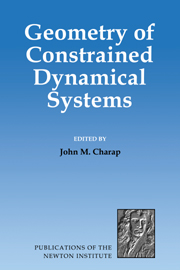Book contents
- Frontmatter
- Contents
- The network
- Preface
- The constraint algebra of higher dimensional Chern-Simons theories
- Nonrelativistic Chern-Simons vortices from the constrained Hamiltonian formalism
- Classical solutions of gravitating Chern-Simons electrodynamics
- Exponentially localised instantons in a hierarchy of Higgs models
- Obstructions to ganging WZ terms: a symplectic curiosity
- Global aspects of symmetries in sigma models with torsion
- Canonical structure of the non-linear σ-model in a polynomial formulation
- A manifestly gauge-invariant approach to quantum theories of gauge fields
- On the Hamiltonian formulation of higher dimensional Chern-Simons gravity
- An Example of Loop Quantization
- Gauge fixing in constrained systems
- Light-cone formulation of gauge theories
- Hamiltonian constraints and Dirac observables
- Gauging kinematical and internal symmetry groups for extended systems
- On the harmonic interaction of three relativistic point particles
- Non existence of static multi-black-hole solutions in 2+1 dimensions
- Spherically symmetric gravity and the notion of time in general relativity
- Canonical decomposition of Belinskii-Zakharov one-soliton solutions
- Hamiltonian reduction and the R-matrix of the Calogero model
- Intrinsic approach to the Legendre transformation in super-mechanics
- Field-antifield description of anomalous theories
- Transfer matrix quantization of general relativity, and the problem of time
- The W3-particle
- Pure geometrical approach to singular Lagrangians with higher derivatives
- Dirac versus reduced phase space quantization
- Classical and quantum aspects of degenerate metric fields
- BRST-antibracket cohomology in 2d conformal gravity
- Quantisation of 2 + 1 gravity for g = 1 and g = 2
- Geometry and dynamics with time-dependent constraints
- Collective coordinates and BRST transformations or Gauge theories without gauge fields
- Geometry of fermionic constraints in superstring theories
- BRST and new superstring states
- Generalized canonical quantization of gauge theories with polarized second–class constraints
- Radiation field on superspace
- Participants
Exponentially localised instantons in a hierarchy of Higgs models
Published online by Cambridge University Press: 05 November 2011
- Frontmatter
- Contents
- The network
- Preface
- The constraint algebra of higher dimensional Chern-Simons theories
- Nonrelativistic Chern-Simons vortices from the constrained Hamiltonian formalism
- Classical solutions of gravitating Chern-Simons electrodynamics
- Exponentially localised instantons in a hierarchy of Higgs models
- Obstructions to ganging WZ terms: a symplectic curiosity
- Global aspects of symmetries in sigma models with torsion
- Canonical structure of the non-linear σ-model in a polynomial formulation
- A manifestly gauge-invariant approach to quantum theories of gauge fields
- On the Hamiltonian formulation of higher dimensional Chern-Simons gravity
- An Example of Loop Quantization
- Gauge fixing in constrained systems
- Light-cone formulation of gauge theories
- Hamiltonian constraints and Dirac observables
- Gauging kinematical and internal symmetry groups for extended systems
- On the harmonic interaction of three relativistic point particles
- Non existence of static multi-black-hole solutions in 2+1 dimensions
- Spherically symmetric gravity and the notion of time in general relativity
- Canonical decomposition of Belinskii-Zakharov one-soliton solutions
- Hamiltonian reduction and the R-matrix of the Calogero model
- Intrinsic approach to the Legendre transformation in super-mechanics
- Field-antifield description of anomalous theories
- Transfer matrix quantization of general relativity, and the problem of time
- The W3-particle
- Pure geometrical approach to singular Lagrangians with higher derivatives
- Dirac versus reduced phase space quantization
- Classical and quantum aspects of degenerate metric fields
- BRST-antibracket cohomology in 2d conformal gravity
- Quantisation of 2 + 1 gravity for g = 1 and g = 2
- Geometry and dynamics with time-dependent constraints
- Collective coordinates and BRST transformations or Gauge theories without gauge fields
- Geometry of fermionic constraints in superstring theories
- BRST and new superstring states
- Generalized canonical quantization of gauge theories with polarized second–class constraints
- Radiation field on superspace
- Participants
Summary
Introduction
The systematic construction of hierarchies of Abelian (in d=2) and non-Abelian (in d>2) Higgs models in d dimensions which support finite action and topologically stable lump solutions, was reviewed in Ref.[l]. Very briefly, the method involves the construction of a hierarcy of Yang-Mills (YM) models in all even dimensions supporting such lump solutions, and then subjecting these to dimensional reduction where the residual systems are the hierarchies of Higgs models in question.
In this article we shall investigate in more detail, the asymptotic properties of the lumps of the Higgs models. These are very different from the asymptotic properties of the even (higher) dimensional YM hierarchies whose connectionfields have a pure-gauge type of behaviour at infinity, their lumps are localised with a power behaviour, and in those cases where these systems are scale invariant this localisation exhibits a further scale arbitrariness. By contrast, the lumps of the hierarchies of Higgs models are in general exponentially localised to an absolute scale. This property is potentially very important from the viewpoint of physical applications and hence is highlighted in the title of this article.
The material is presented in two sections below. In the first, we present the hierarchy of Higgs models in d dimensions in a formal way and examine particular asymptotic properties of the lumps by examining the fields in the (Dirac) string-gauge.
- Type
- Chapter
- Information
- Geometry of Constrained Dynamical Systems , pp. 23 - 31Publisher: Cambridge University PressPrint publication year: 1995

